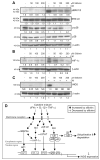Silibinin inhibits cytokine-induced signaling cascades and down-regulates inducible nitric oxide synthase in human lung carcinoma A549 cells
- PMID: 18644994
- PMCID: PMC2587409
- DOI: 10.1158/1535-7163.MCT-08-0256
Silibinin inhibits cytokine-induced signaling cascades and down-regulates inducible nitric oxide synthase in human lung carcinoma A549 cells
Abstract
Recently, we reported that silibinin inhibits primary lung tumor growth and progression in mice and down-regulates inducible nitric oxide synthase (iNOS) expression in tumors; however, the mechanisms of silibinin action are largely not understood. Also, the activation of signaling pathways inducing various transcription factors are associated with lung carcinogenesis and their inhibition could be an effective strategy to prevent and/or treat lung cancer. Herein, we used human lung epithelial carcinoma A549 cells to explore the potential mechanisms and observed strong iNOS expression by cytokine mixture (containing 100 units/mL IFN-gamma + 0.5 ng/mL interleukin-1beta + 10 ng/mL tumor necrosis factor-alpha). We also examined the cytokine mixture-activated signaling cascades, which could potentially up-regulate iNOS expression, and then examined the effect of silibinin (50-200 mumol/L) on these signaling cascades. Silibinin treatment inhibited, albeit to different extent, the cytokine mixture-induced activation of signal transducer and activator of transcription 1 (Tyr(701)), signal transducer and activator of transcription 3 (Tyr(705)), activator protein-1 family of transcription factors, and nuclear factor-kappaB. The results for activator protein-1 were correlated with the decreased nuclear levels of phosphorylated c-Jun, c-Jun, JunB, JunD, phosphorylated c-Fos, and c-Fos. Further, silibinin also strongly decreased cytokine mixture-induced phosphorylation of extracellular signal-regulated kinase 1/2 but only marginally affected JNK1/2 phosphorylation. Silibinin treatment also decreased constitutive p38 phosphorylation in the presence or absence of cytokine mixture. Downstream of these pathways, silibinin strongly decreased cytokine mixture-induced expression of hypoxia-inducible factor-1alpha without any considerable effect on Akt activation. Cytokine mixture-induced iNOS expression was completely inhibited by silibinin. Overall, these results suggest that silibinin could target multiple cytokine-induced signaling pathways to down-regulate iNOS expression in lung cancer cells and that could contribute to its overall cancer preventive efficacy against lung tumorigenesis.
Figures






Similar articles
-
Silibinin modulates TNF-α and IFN-γ mediated signaling to regulate COX2 and iNOS expression in tumorigenic mouse lung epithelial LM2 cells.Mol Carcinog. 2012 Oct;51(10):832-42. doi: 10.1002/mc.20851. Epub 2011 Aug 31. Mol Carcinog. 2012. PMID: 21882257
-
Silibinin inhibits UVB- and epidermal growth factor-induced mitogenic and cell survival signaling involving activator protein-1 and nuclear factor-kappaB in mouse epidermal JB6 cells.Mol Cancer Ther. 2006 May;5(5):1145-53. doi: 10.1158/1535-7163.MCT-05-0478. Mol Cancer Ther. 2006. PMID: 16731746
-
Silibinin prevents lung tumorigenesis in wild-type but not in iNOS-/- mice: potential of real-time micro-CT in lung cancer chemoprevention studies.Clin Cancer Res. 2011 Feb 15;17(4):753-61. doi: 10.1158/1078-0432.CCR-10-2290. Epub 2010 Dec 10. Clin Cancer Res. 2011. PMID: 21148748 Free PMC article.
-
Candidate pathways linking inducible nitric oxide synthase to a basal-like transcription pattern and tumor progression in human breast cancer.Cell Cycle. 2011 Feb 15;10(4):619-24. doi: 10.4161/cc.10.4.14864. Epub 2011 Feb 15. Cell Cycle. 2011. PMID: 21293193 Free PMC article. Review.
-
Regulation of inducible nitric oxide synthase gene in glial cells.Antioxid Redox Signal. 2006 May-Jun;8(5-6):929-47. doi: 10.1089/ars.2006.8.929. Antioxid Redox Signal. 2006. PMID: 16771683 Free PMC article. Review.
Cited by
-
The ameliorative effect of silibinin against radiation-induced lung injury: protection of normal tissue without decreasing therapeutic efficacy in lung cancer.BMC Pulm Med. 2015 Jul 5;15:68. doi: 10.1186/s12890-015-0055-6. BMC Pulm Med. 2015. PMID: 26143275 Free PMC article.
-
Silibinin attenuates sulfur mustard analog-induced skin injury by targeting multiple pathways connecting oxidative stress and inflammation.PLoS One. 2012;7(9):e46149. doi: 10.1371/journal.pone.0046149. Epub 2012 Sep 27. PLoS One. 2012. PMID: 23029417 Free PMC article.
-
The Effects of Silibinin Combined With EGFR-TKIs in the Treatment of NSCLC.Cancer Med. 2025 Feb;14(3):e70643. doi: 10.1002/cam4.70643. Cancer Med. 2025. PMID: 39907159 Free PMC article. Review.
-
Implications of estrogen and its receptors in colorectal carcinoma.Cancer Med. 2023 Feb;12(4):4367-4379. doi: 10.1002/cam4.5242. Epub 2022 Oct 7. Cancer Med. 2023. PMID: 36207986 Free PMC article. Review.
-
Chemopreventive and anti-cancer efficacy of silibinin against growth and progression of lung cancer.Nutr Cancer. 2013;65 Suppl 1(0 1):3-11. doi: 10.1080/01635581.2013.785004. Nutr Cancer. 2013. PMID: 23682778 Free PMC article. Review.
References
-
- Jemal A, Siegel R, Ward E, Murray T, Xu J, Thun MJ. Cancer statistics, 2007. CA Cancer J Clin. 2007;57:43–66. - PubMed
-
- Brown JR, DuBois RN. Cyclooxygenase as a target in lung cancer. Clin Cancer Res. 2004;10:4266s–69s. - PubMed
-
- Singh RP, Deep G, Chittezhath M, et al. Effect of silibinin on the growth and progression of primary lung tumors in mice. J Natl Cancer Inst. 2006;98:846–55. - PubMed
-
- Singh RP, Agarwal R. Natural flavonoids targeting deregulated cell cycle progression in cancer cells. Curr Drug Targets. 2006;7:345–54. - PubMed
-
- Deep G, Agarwal R. Chemopreventive efficacy of silymarin in skin and prostate cancer. Integr Cancer Ther. 2007;6:130–45. - PubMed
Publication types
MeSH terms
Substances
Grants and funding
LinkOut - more resources
Full Text Sources
Medical
Research Materials
Miscellaneous

